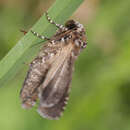Biology
provided by Arkive
This species is usually single-brooded; the adults are active between mid-May and July, but there is some evidence of a second brood (4). The caterpillars feed on the seed capsules of the Nottingham catchfly (2) between July and August and the overwintering stage is the pupa (1). The foodplant has sticky stems, hence the common name 'catchfly' (5), and once grew in abundance on the walls of Nottingham Castle and the surrounding castle rock (5). It was first given its present name in 1770 (5), and is currently widespread but local and grows on shingle or rocky cliffs with sparse soil (6).
Conservation
provided by Arkive
The white spot moth is a UK BAP (Biodiversity Action Plan) priority species. The plan aims to maintain the present populations by considering the species with habitat action plans for coastal vegetated shingle and maritime cliffs and slopes. A regular monitoring programme has been proposed, furthermore Dungeness is a candidate SAC (Special Area of Conservation) (2).
Description
provided by Arkive
This species is easily recognised by the large white spots on the forewings, referred to by both the common and scientific names (albimacula derives from the Latin 'albico'- to be white and 'macula'- spot). The hindwings are brown in colour, becoming darker towards the edge (3).
Habitat
provided by Arkive
Inhabits shingle beaches and calcareous cliffs where the foodplant of the caterpillars, Nottingham catchfly (Silene nutans) is present (2).
Range
provided by Arkive
Populations of the white spot moth are currently known in Dungeness in Kent, near Gosport in Hampshire, and on the south coast of Devon. Over the last 25 years, the range of the species in Devon has declined to a great extent. Although it could be described as 'abundant' in Dungeness (4), all current populations are vulnerable. The species is known from most European countries (2).
Status
provided by Arkive
Classified as Vulnerable in Great Britain (2).
Threats
provided by Arkive
The white spot moth is limited by the availability of its foodplant, Nottingham catchfly, which is scarce. Recreation by humans, coastal development, coastal defence work and commercial-scale extraction of shingle, gravel and sand have all put this species under pressure (2).
Hadena albimacula
provided by wikipedia EN
Hadena albimacula, the white spot, is a species of moth of the family Noctuidae. It is found in Europe.
Technical description and variation
The wingspan is 30–38 mm. Forewing olive brown; the lines black, slightly picked out with white scales; claviform stigma of ground colour edged at end with black , followed by a quadrate white blotch ; orbicular round and white with slight grey centre ; reniform edged internally with white; both outlined with black; small white blotches beyond orbicular and between veins 2 and 3 at base; a whitish blotch at base of costa and a white costal spot above orbicular stigma; hindwing dark fuscous; basal half greyer, with darker veins. — Larva brownish ochreous; dorsal line fine, indistinct, marked by blackish spots which connect the subdorsal oblique stripes; lateral lines pale grey; spiracles white ringed with black.[1]
Biology
The moth flies from May to August depending on the location.
The larvae feed on Silene species.
References
-
^ Warren. W. in Seitz, A. Ed., 1914 Die Großschmetterlinge der Erde, Verlag Alfred Kernen, Stuttgart Band 3: Abt. 1, Die Großschmetterlinge des palaearktischen Faunengebietes, Die palaearktischen eulenartigen Nachtfalter, 1914
 This article incorporates text from this source, which is in the public domain.
This article incorporates text from this source, which is in the public domain.

- license
- cc-by-sa-3.0
- copyright
- Wikipedia authors and editors
Hadena albimacula: Brief Summary
provided by wikipedia EN
Hadena albimacula, the white spot, is a species of moth of the family Noctuidae. It is found in Europe.
- license
- cc-by-sa-3.0
- copyright
- Wikipedia authors and editors

